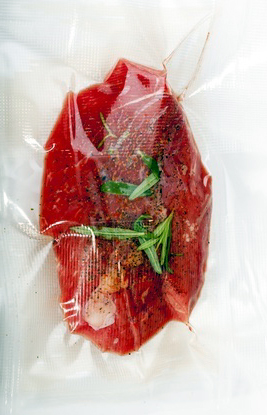 When it comes to cooking methods, there are clearly a lot of choices. From the grill to the fryer to the sauté pan and beyond, each one offers a different taste and texture option to your customers. But many of these methods put you at risk of cross-contamination and undercooked meats. That’s where sous vide comes in. Perhaps you have heard of it, but maybe you haven’t. Regardless, it’s a cooking method you’ll want to pay attention. Sous vide may be the answer to your food safety concerns, while also providing many other benefits.
When it comes to cooking methods, there are clearly a lot of choices. From the grill to the fryer to the sauté pan and beyond, each one offers a different taste and texture option to your customers. But many of these methods put you at risk of cross-contamination and undercooked meats. That’s where sous vide comes in. Perhaps you have heard of it, but maybe you haven’t. Regardless, it’s a cooking method you’ll want to pay attention. Sous vide may be the answer to your food safety concerns, while also providing many other benefits.
What is Sous Vide?
Just in case you are not familiar with the term, sous vide is actually French for “under vacuum,” but that only describes a part of what it is.
Essentially, sous vide cooking is when the food (usually meat, but sometimes vegetables) is placed in a vacuum-sealed, airtight, food-grade plastic bag and submerged in temperature-controlled water for an extended period of time.
What Are the Benefits of Sous Vide?
The combination of extended cooking times, lower temperatures, and sealed pouches result in many benefits for both you and your customer. Here are a few of them:
- Elimination of cross-contamination risk. Since the meat is completely sealed off during the entire cooking process, you don’t have to worry at all about this element of food safety. By the time you remove the food from the bag, there will be no raw meat exposed. Of course, this doesn’t eliminate all concerns about handle raw meat if you’re receiving an uncooked product that you vacuum-seal yourself. So make sure to use caution when prepping the meat and placing it into the pouches.
- Thoroughly cooked food. One of the greatest perks of sous vide, according to Modernist Cuisine, is the ability of this technique to cook food all the way through without charring the exterior. You don’t have to worry about your customer biting into a raw piece of chicken or an underdone steak. However, it is important to note that many chefs do sear the outside of the meat before serving it to get the browned appearance, taste, and finishing texture many patrons expect.
- A consistent product. Traditional cooking methods like grilling or frying require a skilled chef to turn out a consistent product. All it takes is a few seconds too long to end up with a rubbery, less-than-perfect end result. With sous vide, however, even an unskilled cook can consistently turn out quality. Over-cooking sous vide-- for the same amount of time as more traditional methods that would result in a ruined meal— will have little to no effect on the finishing taste and texture.
- Better flavor. If you still aren’t convinced that sous vide should definitely be added to your cooking repertoire, the improved flavor might persuade you. The food prepared this way ends up juicier and more tender than its grilled counterparts. Think about it: there is nowhere for the juices to escape in a vacuum-sealed package, and since the bag is filled with humidity throughout the entire process, the meat ends up plump and savory.
- Provides more nutrition. Finally, the nutrition benefits are certainly worth mentioning. Since everything the food offers is contained during the cooking procedure (instead of evaporating or being left at the bottom of the pan), all of the vitamins and minerals that the food delivers will still be there when the item is served. It may not be a visible advantage, but it is surely one that will be appreciated.
There you have it: The abundance of benefits of bringing sous vide cooking into your establishment. If done properly, it will eliminate many food safety concerns while providing your guests with a delectable, tender piece of meat that will not be easily rivaled by your competition.







